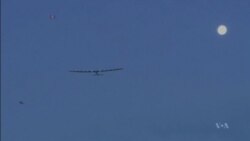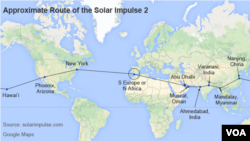A solar-powered Swiss airplane touched down Friday in Hawaii after a record-breaking flight across the Pacific Ocean, the riskiest leg of its 35,000-kilometer trip around the world without a drop of fuel.
Solar Impulse 2 (Si2) pilot Andre Borschberg's 120 hour voyage beat the previous longest solo piloting record that was held by American adventurer Steve Fossett who flew around the world in 76 hours in a specially designed jet.
Borchberg took 20-minute naps during the journey in the unpressurized cockpit while the aircraft was on autopilot.
Si2 flew took off from Nagoya, Japan early Monday after an unscheduled month-long stop. The aircraft was diverted to Nagoya because of bad weather at the beginning of June on its trip from Nanjing in eastern China to Hawaii.
Swiss adventurer Bertrand Piccard will fly the same aircraft on the next leg from Hawaii to the city of Phoenix, Arizona. From there Solar Impulse is scheduled to fly to New York, before crossing the Atlantic Ocean to its final destination, Abu Dhabi, in United Arab Emirates.
Solar Impulse 2 is the brainchild of the two Swiss scientists, Borschberg and Piccard who began the project in 2002.
"Can you imagine that a solar-powered airplane without fuel can now fly longer than a jet plane?'' Piccard said in a statement. "This is a clear message that clean technologies can achieve impossible goals.''
Achieving the 'impossible'
The carbon fiber single-seat Si2 has a 72-meter wingspan, which is longer than the wingspan of a Boeing 747, and weighs about as much as a car. The 17,000 solar cells built into the wings harness the sun's energy.
Piccard and Borschberg say they are not out to revolutionize the aviation industry, but are instead aiming to demonstrate that alternative energy sources and new technologies can achieve what some consider impossible.
The aircraft's route included stops in Oman, India, Myanmar and China. After its Pacific voyage, the plane will make up to three stops in the U.S., touching down in Phoenix, Arizona and New York City, and possibly another location depending on weather conditions.
The final legs after crossing the Atlantic include a stopover in southern Europe or North Africa before arriving back in Abu Dhabi, where the journey started, in late July or early August.









